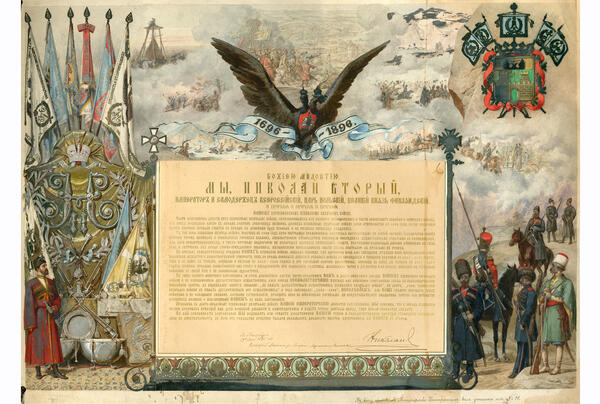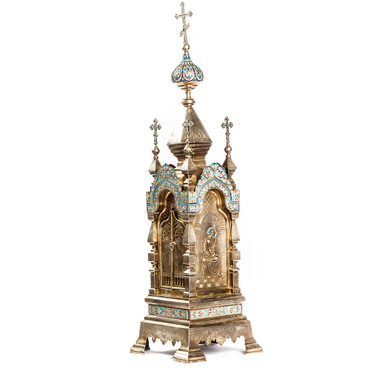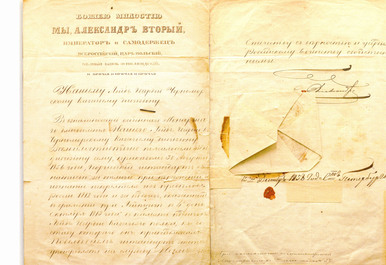In 1896 the Kuban Cossack Host celebrated its 200th anniversary. To commemorate this event, Emperor Nicholas II awarded the Cossacks the Banner of St. George, a silver dish, and the commendation letter, which stated, ‘We command to read our commendation in front of the Host and add the letter to the regalia of the host after the consecration of the flag, according to the established procedure.’
The commendation was printed, decorated with gilding and watercolor drawings — scenes from Russian military history and images of military regalia. At the top of the sheet is a double-headed eagle — the symbol of the Russian Empire. In his paws, it holds a blue ribbon with the dates ‘1696–1896’. Between the wings of the eagle is an engraving depicting the siege of Azov in 1696. Also at the top of the commendation letter are watercolor scenes from the military life of the Cossacks. In the upper corners is the coat of arms of the Kuban region, the image of the St. George Cross, and the awards ‘For service in the Caucasus’.
The anniversary of the Kuban Cossack Host was celebrated on September 8, 1896. All those Cossacks who were in the military service at the time, as well as retired officers and military officials, were invited to the festivities. Altogether, there were 849 guests on the list compiled by the Jubilee Commission. Parade dress uniform was to be worn on this occasion. Before the start of the festivities, a solemn meeting of the troops was held, at which Cossacks were presented with anniversary awards. 111 people participated in it.
On the second day, September 9, celebrations were also open to Cossack families. However, to get to the festival, one had to buy an entrance ticket. There was no longer any dress code.
On September 9, a monument to Empress Catherine II was founded in Ataman Square (now Catherine Square at the beginning of the city’s main street, Krasnaya Street). It was designed by the famous sculptor of that time Mikhail Mikeshin — the author of the Millennium of Russia monument in Novgorod. Troops were specially assigned to participate in the ceremony, and the square was decorated with flags. A separate gazebo was built for the priests who were invited to celebrate a moleben — a festive Orthodox service.
The commendation was printed, decorated with gilding and watercolor drawings — scenes from Russian military history and images of military regalia. At the top of the sheet is a double-headed eagle — the symbol of the Russian Empire. In his paws, it holds a blue ribbon with the dates ‘1696–1896’. Between the wings of the eagle is an engraving depicting the siege of Azov in 1696. Also at the top of the commendation letter are watercolor scenes from the military life of the Cossacks. In the upper corners is the coat of arms of the Kuban region, the image of the St. George Cross, and the awards ‘For service in the Caucasus’.
The anniversary of the Kuban Cossack Host was celebrated on September 8, 1896. All those Cossacks who were in the military service at the time, as well as retired officers and military officials, were invited to the festivities. Altogether, there were 849 guests on the list compiled by the Jubilee Commission. Parade dress uniform was to be worn on this occasion. Before the start of the festivities, a solemn meeting of the troops was held, at which Cossacks were presented with anniversary awards. 111 people participated in it.
On the second day, September 9, celebrations were also open to Cossack families. However, to get to the festival, one had to buy an entrance ticket. There was no longer any dress code.
On September 9, a monument to Empress Catherine II was founded in Ataman Square (now Catherine Square at the beginning of the city’s main street, Krasnaya Street). It was designed by the famous sculptor of that time Mikhail Mikeshin — the author of the Millennium of Russia monument in Novgorod. Troops were specially assigned to participate in the ceremony, and the square was decorated with flags. A separate gazebo was built for the priests who were invited to celebrate a moleben — a festive Orthodox service.



